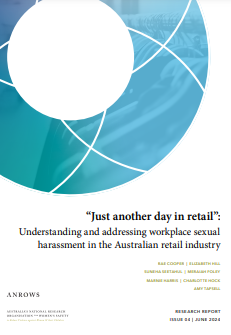By Kate Fitz-Gibbon, Sandra Walklate, Jasmine McGowan, JaneMaree Maher, Jude McCulloch
This project aimed to develop new understandings of risk and system interactions prior to intimate femicide in order to build the evidence base required to inform early intervention and the prevention of intimate femicide in Australia. Drawing on a quantitative and qualitative analysis of intimate femicide sentencing decisions imposed over a decade in Australian superior courts, the new knowledge generated from this project is intended to inform and assist in developing a more risk-sensitive approach to preventing and responding to intimate femicide in Australia and overseas, thereby enhancing women’s security.
This report presents findings from the collection of over 250 intimate femicide sentencing judgments and the in-depth analyses of 235 of these. These judgements were used, in part, to identify potential points of intervention that might have provided an opportunity to prevent such killings.
In Australia, at least one woman a week is murdered by her current or former partner. According to Destroy the Joint, this equated to the killing of at least 57 women in 2022 and at least 64 women in 2023 allegedly as a result of men’s violence. At the time of finalising this report, an unusually high number of killings allegedly by men’s violence in the first four months of 2024 in Australia has reignited national attention over the need to better address women’s risk of fatal violence (see, inter alia, AAP, 2024; Priestley, 2024; Tuohy, 2024).
Intimate partner homicides are recognised as the most preventable type of homicide because it is assumed that histories of abuse can provide clear indicators of risk (see, inter alia, Bugeja et al., 2013; Dearden & Jones, 2008; Virueda & Payne, 2010). While intimate partner homicides are monitored and examined in Australia via the work of the Australian Institute of Criminology and state-based death review teams, there is no fully funded, multi-systems approach to the prevention of men’s lethal violence against women (McPhedran & Baker, 2012). As in Australia, international efforts to review and count such deaths are carried out in different ways and are often fraught with difficulties (see, inter alia, Walklate et al., 2020; Dawson & Vega, 2023).
In Australia and comparable international jurisdictions, a range of provisions, measures, laws and programs are designed to assess and address the risk of intimate partner violence. These include civil orders alongside programs that provide increased levels of protection and monitoring for women deemed at high risk of repeat victimisation. These instruments include the development of various risk assessment and management frameworks (Walklate et al., 2020). While magistrates, police and specialist support services use these instruments to identify and respond to risk (Boxall et al., 2015; Robinson & Moloney, 2010; Wakefield & Taylor, 2015), there is evidence that these approaches are limited by their conceptualisations of risk and in their scale of implementation and inconsistency in application.
This project sought to contribute new evidence to inform the further development of whole-of-systems preventive approaches to repeat violence and intimate femicide. Specifically, the project aimed to build evidence based on the following touchpoints:
Places where an intervention between the initial emergence of family violence and the fatal outcomes had occurred.
What could potentially be known about those points of intervention.
If/how the pathway from intervention to safety could be better supported.
This report presents findings from the collection of over 250 intimate femicide sentencing judgments and the in-depth analyses of 235 of these. These judgements were used, in part, to identify potential points of intervention that might have provided an opportunity to prevent such killings. Sentencing judgments typically include narrative accounts from a judge, who describes how and where the crime took place as well as the circumstances that led to it.
This project builds current understandings of the potential points of intervention prior to the killing of women by their male intimate partners. In doing so, this project has contributed to building understanding of who perpetrates intimate femicide.
Melbourne: Monash University, 2024. 40p.





















